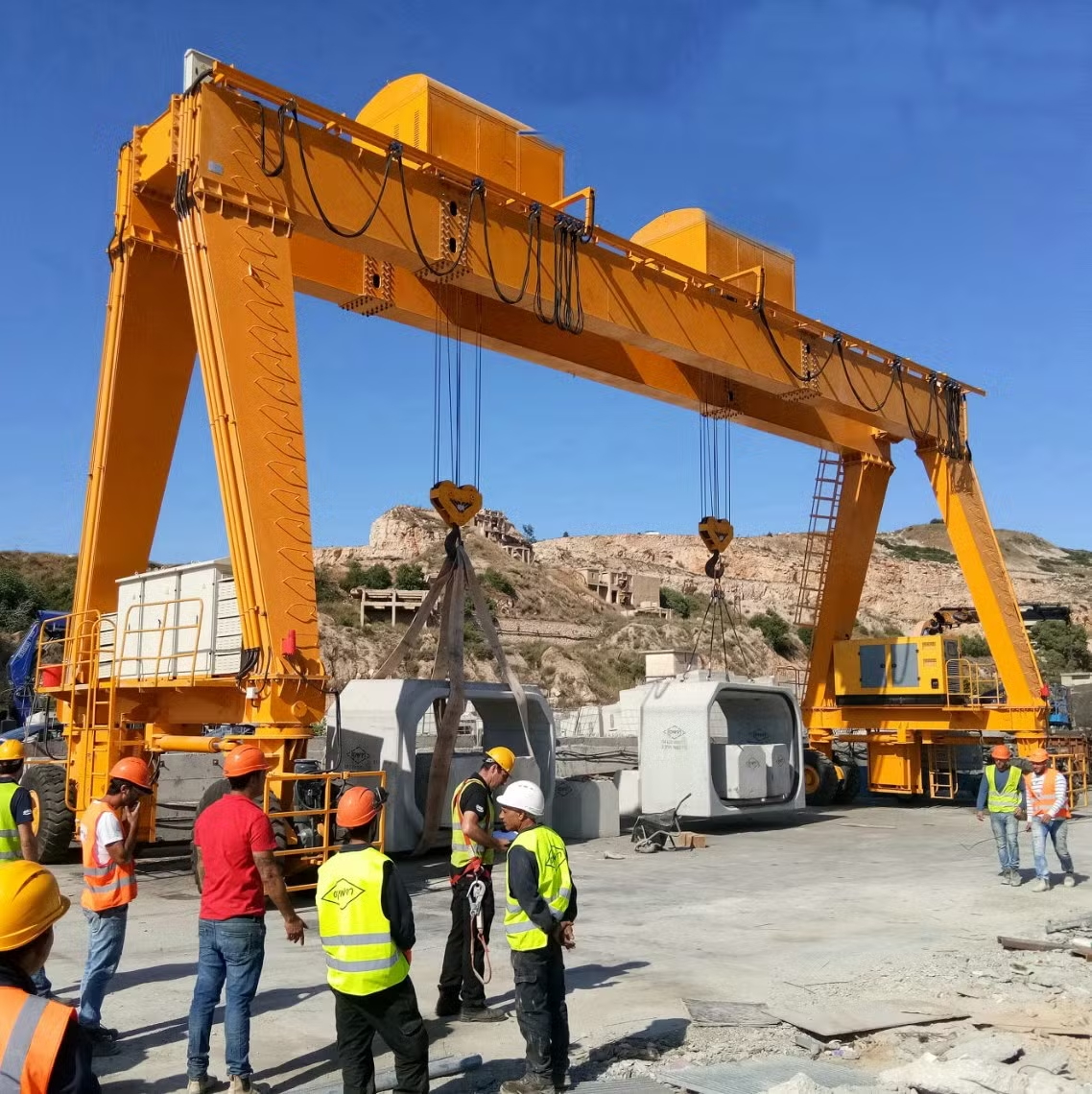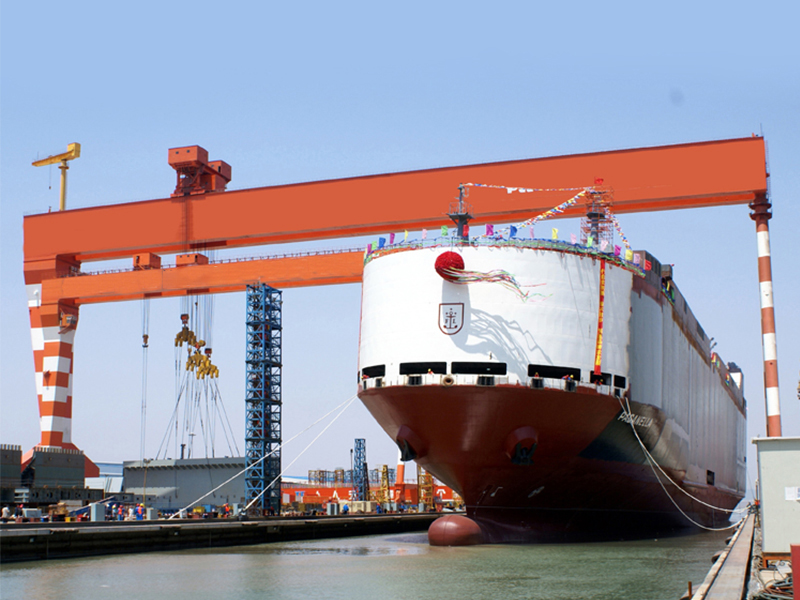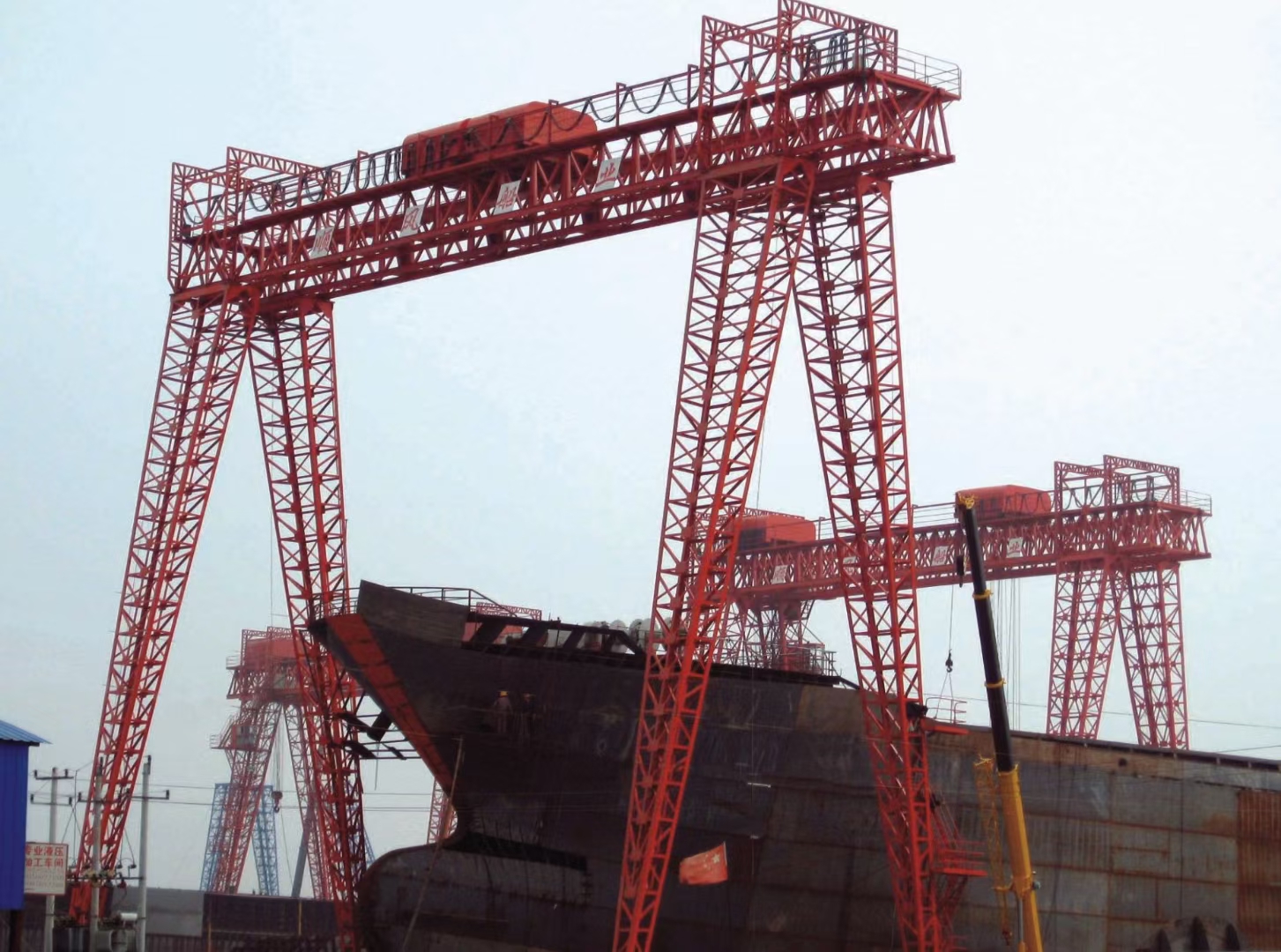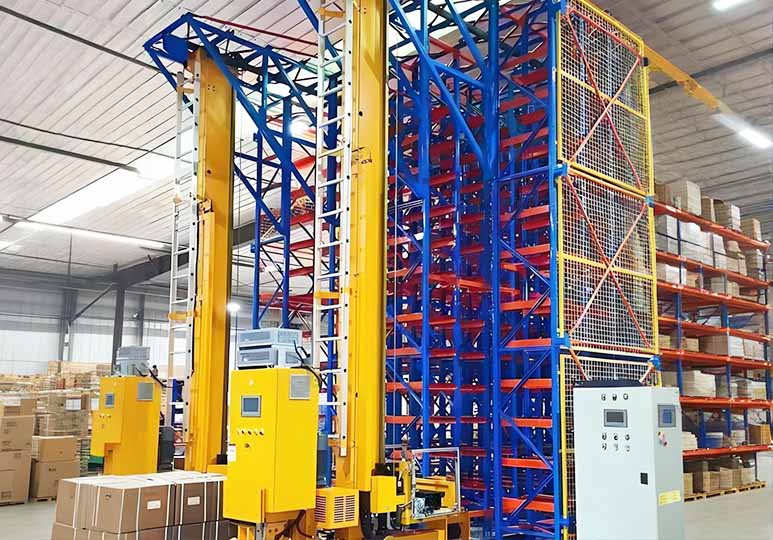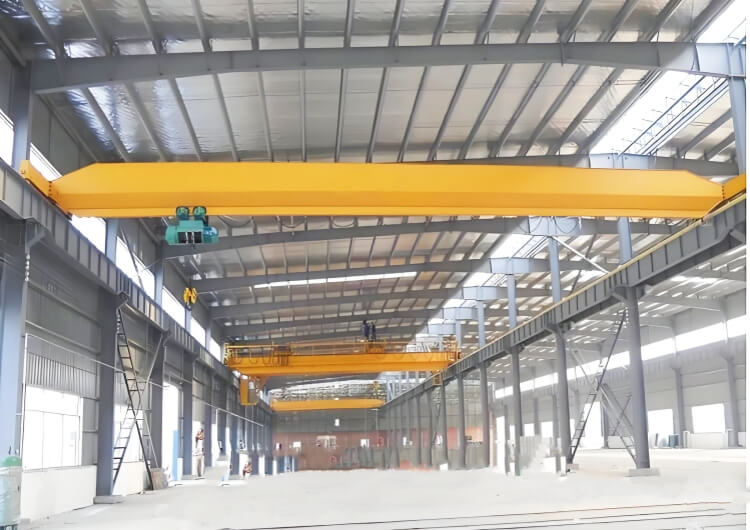Shipbuilding Gantry Cranes for Different Ship Types – Capacity, Span and Configuration Guide | SLKJCrane
In modern modular shipbuilding, the real bottleneck for productivity and build quality is no longer only steel processing – it is whether your shipyard can safely and accurately lift very large hull blocks and complex pre-assembled modules.
SLKJCrane focuses on high-end shipyards around the world and provides custom shipbuilding gantry crane solutions that combine:
High lifting capacity and extra-wide spans
Precise multi-point control for long blocks
Reliable performance in harsh coastal environments
In this guide we explain:
What a shipbuilding gantry crane is and where it is used
How it supports hull section and deck module handling
A ship-type-specific selection table (capacity, span, height, configuration)
What engineers and buyers should look at before ordering
Why leading shipyards choose SLKJCrane as a long-term partner
1. What Is a Shipbuilding Gantry Crane?
A shipbuilding gantry crane (also called a shipyard gantry crane) is a heavy-duty gantry system designed specifically for:
Lifting and positioning hull sections (bow, stern and midship blocks)
Installing pre-fabricated deck modules and superstructures
Handling pre-outfitted modules such as cabins, engine-room blocks and piping units
Compared with general-purpose gantry cranes, a shipbuilding gantry crane usually features:
Very large span (up to 40–120 m or more) to cover slipways, dry docks and multiple assembly lines
High lifting capacity, typically from 100 t up to 800 t or higher
Dual trolleys and multi-hoist configurations for long and heavy hull blocks
Anti-corrosion and anti-wind design for marine outdoor environments
Advanced control and safety systems that match the standards of modern shipyards
In practice, your shipbuilding gantry crane determines:
How fast hull blocks move from fabrication to assembly
How many ships you can build in parallel
Whether you can upgrade to larger or more complex vessels in the next 10–15 years
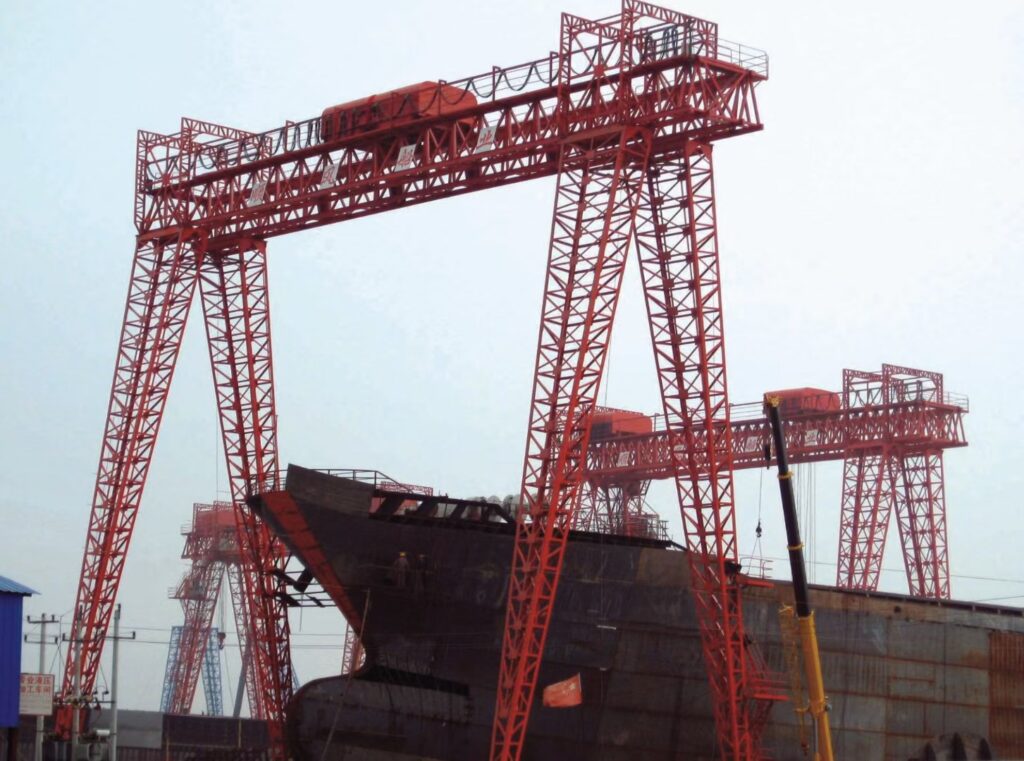
2. Key Applications in Modern Shipyards
2.1 Hull Section Lifting and Block Joining
Ship hull sections are often:
Irregular in shape – curved bows, sterns with shaft tunnels or rudder foundations
Very heavy – midship blocks commonly reach 80–300 t or more
Highly sensitive to lifting-point positions and deformation
A well-designed shipbuilding gantry crane allows you to:
Use dual trolleys or multiple hoists to keep long blocks perfectly balanced
Perform accurate vertical and horizontal movements during block joining
Safely transport sections from pre-fabrication bays to slipways or dry docks
The maximum hull block weight and size are the primary inputs when SLKJCrane designs crane capacity, span and lifting height for your yard.
2.2 Deck Modules and Superstructure Installation
To shorten construction time, many yards build as much as possible on the ground:
Deckhouses and accommodation blocks
Pre-outfitted cabins and machinery modules
Piping skids and electrical rooms
A shipyard gantry crane with fine speed control and precise positioning helps you:
Lift large modules in one piece instead of many small lifts
Reduce work at height and improve safety
Achieve better alignment accuracy, reducing rework and fairing
2.3 Slipway and Dry Dock Operations
Over slipways and dry docks, the crane works in:
Open-air coastal environments – strong wind, salt spray, high humidity
Long-travel duty – covering multiple ships or large dock areas
High safety level conditions – launching, dry-docking and critical lifts
SLKJCrane designs shipbuilding gantry cranes with:
Storm brakes, rail clamps and anchoring systems for high-wind conditions
Structural calculations for strength and stiffness under heavy loads
Tailored marine-grade coating systems to extend service life
3. Ship Type Specific Selection Table for Shipbuilding Gantry Cranes
Different ship types have very different block weights, geometry, module complexity and risk profiles. To make engineering discussions easier, SLKJCrane uses the following framework as a starting point when we design shipbuilding gantry cranes for customers.
⚠️ The data below are typical ranges and not fixed catalog values. Every project is finally verified against your yard layout, hull block list and future vessel plan.
3.1 Recommended Parameters by Ship Type
| Ship type category | Typical max block / module weight (t) | Recommended SWL (t) (incl. 10–25% margin) | Recommended span (m) | Recommended lifting height (m) | Core configuration requirements | Matching SLKJCrane series |
|---|---|---|---|---|---|---|
| Luxury yachts (20–50 m) | 15–30 | 33–37.5 | 40–50 | 20–25 | 1) Single trolley with twin hooks for stable block lifting; 2) High-precision positioning system (accuracy ≤ ±5 mm) to match curved yacht hulls; 3) Low-noise operation (≤ 75 dB) to avoid disturbing precision outfitting; 4) Lightweight structure to reduce foundation loads | RTG – Light-Duty Custom Series |
| Workboats (tugs / pilot boats) | 20–40 | 44–50 | 45–55 | 22–28 | 1) Reinforced anti-wind devices (designed for up to Beaufort 10); 2) Simple remote control (effective range ≥ 50 m) for flexible operation; 3) Mobile chassis design supporting quick relocation (travel speed ≥ 3 km/h); 4) Emergency brake response time ≤ 0.5 s | Rail-Mounted Basic Series |
| Feeder container ships (1,000–2,000 TEU) | 50–80 | 88–100 | 60–70 | 25–30 | 1) Dual trolleys with synchronized control (speed difference ≤ ±2 mm/s) for long deck modules; 2) Anti-sway system (swing angle ≤ 3°) to speed up alignment; 3) Medium anti-corrosion coating (C4) for coastal environments; 4) Trolley travel speed ≥ 10 m/min to match production cycles | Dual-Carrier Standard Series |
| Ro-pax ferries (passenger / Ro-Ro) | 60–100 | 110–125 | 65–75 | 28–32 | 1) Multi-lifting-point configuration with adjustable spacing (1–5 m) for irregular hull modules; 2) Special lifting beams compatible with rectangular and trapezoidal blocks; 3) Upgraded overload protection (warning at 90% SWL, cut-off at 110%); 4) Two-level hoisting speed control (no-load ≥ 15 m/min, full load ≥ 5 m/min) | Heavy-Lift Balanced Series |
| Bulk carriers (30,000–80,000 DWT) | 120–200 | 220–250 | 70–85 | 30–35 | 1) Dual trolleys with independent drives for flexible single/dual-trolley operation; 2) Enhanced structural stiffness (main-girder deflection ≤ L/1000, L = span); 3) Anti-wind devices designed up to Beaufort 12 (rail clamps + storm anchors); 4) Optimized drum grooves (hardness ≥ HB300) to extend wire rope life | Super-Heavy Bulk Carrier Series |
| Oil tankers (100,000–150,000 DWT) | 180–300 | 330–375 | 80–95 | 32–38 | 1) 3–4 lifting points with synchronized control for large engine-room and pump-room modules; 2) Explosion-proof electricals (Ex d IIB T4 Gb) to meet oil tanker safety standards; 3) Marine-grade anti-corrosion system (C5-M, coating thickness ≥ 200 μm) for high salt-spray environments; 4) Real-time load monitoring (accuracy ±1%) to prevent overload | Oil-Tanker Special Series |
| Ro-Ro / PCTC car carriers | 150–220 | 275–300 | 75–90 | 33–36 | 1) Wide spreader beams (adjustable length 8–15 m) to cover Ro-Ro deck widths; 2) Lateral micro-motion (adjustment range ±300 mm) for accurate hatch alignment; 3) High-frequency duty design with forged-steel wheels (hardness ≥ HRC55); 4) Elevating operator cabin (stroke 2–5 m) for optimal visibility | Ro-Ro Dedicated Custom Series |
| LNG carriers (small to mid-size) | 200–300 | 375–385 | 85–100 | 36–40 | 1) Low-temperature capability (components operating reliably at −40 °C) for LNG-related modules; 2) Stainless steel lifting devices (316L) to avoid rust contamination; 3) Explosion-proof control system (compliant with IEC 60079) for flammable environments; 4) Sealed electrical cabinets (IP65) to prevent moisture ingress | LNG-Special Custom Series |
3.2 Engineering Notes for the Table
Safety margin rule
Conventional ship types (workboats, bulk carriers, feeders): margin calculated at +10% over maximum block/module weight.
High-value / higher-risk ship types (LNG carriers, mega container ships): margin at +25% to balance safety and long-term economics.
Span determination logic
Base span = dock / slipway width + side operating clearances (typically 3–5 m each side).
If one crane must cover multiple building lines, add 15–20 m span per additional line and re-check wheel loads and foundation capacity.
Corrosion protection
C4: medium-corrosive environments such as inland coastal regions or sheltered ports.
C5-M: highly corrosive marine atmospheres (splash zones, open seafront yards).
SLKJCrane adjusts paint systems according to your exact location and maintenance strategy.
Special customization examples
Polar ships and icebreakers: optional −60 °C low-temperature package.
Naval auxiliary ships: upgraded shock-resistance design.
Other unique requirements can be jointly engineered with SLKJCrane’s design team.
If your yard is still in the planning phase, this table helps you quickly estimate the right order of magnitude for shipyard gantry crane capacity and span before moving into detailed engineering.
4. Operational Best Practices for Hull and Deck Handling
Even the best shipbuilding gantry crane must be matched with good practices.
4.1 Pre Lift Planning and Load Calculation
Confirm actual weight and centre of gravity for each block or module
Select lifting points, spreader beams, slings and clamps accordingly
Prepare a written lift plan (path, clearances, height, rotation if any)
Brief all operators and riggers before each critical lift
4.2 Rigging and Multi Point Lifting
Use proper clamps and lifting beams to protect steel surfaces and welds
Control sling angles to prevent localized overloads
For long blocks, always use spreader beams and multi-point lifting
Implement periodic inspection and retirement rules for all rigging equipment
4.3 Synchronization, Anti-Sway and Safety
Synchronize dual trolleys or multiple hoists to keep the block level
Use taglines and anti-sway control to reduce swing, especially in wind
Regularly test overload protection, limit switches, storm brakes and rail clamps
Train operators not only on controls, but also on emergency procedures
5. Why Shipyards Choose SLKJCrane for Shipbuilding Gantry Cranes
SLKJCrane is not only selling “a crane”, but delivering a complete lifting solution for your shipbuilding process.
You can find an overview of our shipbuilding gantry crane offering here:
👉 https://www.slkjcrane.com/gantry-cranes/ship-building-gantry-cranes/
5.1 Layout-Based Custom Engineering
We design around your yard layout, slipways, dry docks and assembly lines
Capacity, span, wheel loads and runway are optimized for performance vs. CAPEX
Dual trolleys, multiple hoists, flipping devices and special lifting beams can be integrated from day one
5.2 Marine-Grade Protection and Storm-Ready Design
Multi-layer anti-corrosion systems tailored to your environment (C4 / C5-M, zinc-rich primers, epoxy + PU topcoats)
Storm brakes, rail clamps and anchoring systems designed for local wind speeds, including typhoon-prone areas
Optional compliance with classification society and national standards as required
5.3 Intelligent Controls and Smooth Handling
VFD (inverter) drives on hoisting, cross travel and long travel for smooth start/stop
Optional anti-sway control to shorten cycle times and improve positioning
Remote control or cabin control, or both, based on your operating philosophy
Advanced options: load monitoring, data logging, condition monitoring for maintenance planning
5.4 Full Project Support and After-Sales Service
Pre-sales engineering based on your block list and production plan
Drawings and load data for foundation and runway design
Manufacturing, factory testing and shipment coordination
On-site erection guidance or remote commissioning, plus operator training and long-term support
6. Ready to Plan Your Shipbuilding Gantry Crane?
Efficient, safe handling of hull sections and deck modules is a core capability of every modern shipyard. A properly selected and well-maintained shipbuilding gantry crane will help you:
Shorten overall construction time and increase annual output
Improve block alignment accuracy and reduce rework
Lower labour intensity and safety risks
Prepare your yard for larger, more complex ships in the future
To start a discussion with SLKJCrane, simply send us:
Your yard layout (PDF / CAD of slipways, docks and assembly lines)
The heaviest blocks and modules (weight, dimensions, approximate centre of gravity)
Target vessel types and annual production plan
Our engineering team will prepare a tailored shipbuilding gantry crane proposal with:
Capacity, span and height recommendations for your ship types
2–3 technical options for comparison
A clear path from concept to delivery and long-term support

Expert in Overhead Crane/Gantry Crane/Jib Crane/Crane Parts Solutions
Eileen
With 20+ years of experience in the Crane Overseas Export Industry, helped 10,000+ customers with their pre-sales questions and concerns, if you have any related needs, please feel free to contact me!
FAQ – Shipbuilding Gantry Cranes
Start from the heaviest hull block or module you expect in the next 10–15 years. Then add 10–25% safety margin depending on vessel type and risk level (higher for LNG / mega container ships). Share your block list with SLKJCrane and we will perform preliminary capacity studies for you.
Yes, if span and runway are designed correctly. Many customers use one large gantry to cover two parallel building lines or a dock plus an outfitting area. We will compare solutions (one large vs. two medium cranes) in terms of cost, flexibility and redundancy.
A shipbuilding gantry crane typically has:
Larger span and higher SWL
Dual trolleys and multi-point lifting for long hull blocks
Stronger structural design and higher corrosion / wind specs
More advanced safety and monitoring systems
Standard yard gantry cranes often cannot meet the full requirements of large shipyards.
Lead time depends on capacity, span, customization and project schedule. Large custom shipbuilding gantry cranes usually take several months from design approval to shipment. Early engagement helps us align crane delivery with your yard or dock commissioning date.
In many cases, yes. We can:
Evaluate your existing rails and foundations
Propose capacity upgrades, control system modernization or new trolleys
Add extra lifting points or convert to dual-trolley systems where structurally possible
For new yards, we can support the concept design stage to avoid later rework.
Latest Blog
Lorem ipsum dolor sit amet, consectetur adipiscing elit, sed do eiusmod tempor incididunt ut labore et dolore magna aliqua
Free Standing Gantry Crane Solutions | SLKJCrane
Free Standing Gantry Crane Solutions for Existing and Leased Buildings Why Many Workshops Struggle to Install an Overhead
Shipbuilding Gantry Crane vs General Gantry Crane
Shipbuilding Gantry Crane vs General Gantry Crane: 7 Key Design Differences In many projects we hear a similar
Shipbuilding Gantry Cranes by Ship Type | Capacity & Span Guide
Shipbuilding Gantry Cranes for Different Ship Types – Capacity, Span and Configuration Guide | SLKJCrane In modern modular
Intelligent Warehouse Overhead Crane 1–20 Ton | Heavy-Duty AS/RS Solutions
Intelligent Warehouse Overhead Crane for Heavy-Duty AS/RS | SLKJCrane In heavy-duty warehouses such as steel coil storage, mold
Contact Us Now
Have questions about our cranes or need help?
Reach out to our friendly team for expert support and guidance.
We are here to help you power your journey towards a greener future !
Address: Crane Industry Park, Xinxiang City Henan Provice

